Fabricating Air Pressure Sensors in Hollow-Core Fiber Using Femtosecond Laser Pulse
Abstract
:1. Introduction
2. Fabrication of Sensors
3. Theoretical Analysis
4. Experimental Results and Analyses
4.1. Experimental Setup
4.2. Air Pressure Experiment of Single-Hole Sensor
4.3. Air Pressure Experiment of Ten-Hole Sensor
4.4. Comparison Experiments of Response Times of Sensors
4.5. Temperature Experiment
5. Conclusions
Author Contributions
Funding
Data Availability Statement
Conflicts of Interest
References
- Tang, J.; Zhang, Z.; Yin, G.; Liu, S.; Bai, Z.; Li, Z.; Deng, M.; Wang, Y.; Liao, C.; He, J.; et al. Long Period Fiber Grating Inscribed in Hollow-Core Photonic Bandgap Fiber for Gas Pressure Sensing. IEEE Photonics J. 2017, 9, 7105307. [Google Scholar] [CrossRef]
- Mao, C.; Huang, B.; Wang, Y.; Huang, Y.; Zhang, L.; Shao, Y. High-sensitivity gas pressure sensor based on hollow-core photonic bandgap fiber Mach-Zehnder interferometer. Opt. Express 2018, 26, 30108–30115. [Google Scholar] [CrossRef] [PubMed]
- Huang, B.; Wang, Y.; Mao, C. Temperature-Independent Gas Pressure Sensor with High Birefringence Photonic Crystal Fiber-Based Reflective Lyot Filter. Sensors 2019, 19, 5312. [Google Scholar] [CrossRef] [PubMed] [Green Version]
- Tang, J.; Yin, G.; Liao, C.; Liu, S.; Li, Z.; Zhong, X.; Wang, Q.; Zhao, J.; Yang, K.; Wang, Y. High-Sensitivity Gas Pressure Sensor Based on Fabry–Pérot Interferometer With a Side-Opened Channel in Hollow-Core Photonic Bandgap Fiber. IEEE Photonics J. 2015, 7, 6803307. [Google Scholar] [CrossRef]
- Zhang, Z.; He, J.; Dong, Q.; Bai, Z.; Liao, C.; Wang, Y.; Liu, S.; Guo, K. Diaphragm-free gas-pressure sensor probe based on hollow-core photonic bandgap fiber. Opt. Lett. 2018, 43, 3017–3020. [Google Scholar] [CrossRef] [Green Version]
- Talataisong, W.; Wang, D.N.; Chitaree, R.; Liao, C.R.; Wang, C. Fiber in-line Mach–Zehnder interferometer based on an inner air-cavity for high-pressure sensing. Opt. Lett. 2015, 40, 1220–1222. [Google Scholar] [CrossRef]
- Liu, Y.; Zhang, T.; Wang, Y.; Yang, D.; Liu, X.; Fu, H.; Jia, Z. Simultaneous measurement of gas pressure and temperature with integrated optical fiber FPI sensor based on in-fiber micro-cavity and fiber-tip. Opt. Fiber Technol. 2018, 46, 77–82. [Google Scholar] [CrossRef]
- Lin, H.; Liu, F.; Dai, Y.; Zhou, A. Cascaded Fiber Mach–Zehnder Interferometers for Sensitivity-Enhanced Gas Pressure Measurement. IEEE Sens. J. 2018, 19, 2581–2586. [Google Scholar] [CrossRef]
- Xu, B.; Liu, Y.; Wang, D.; Jia, D.; Jiang, C. Optical Fiber Fabry–Pérot Interferometer Based on an Air Cavity for Gas Pressure Sensing. IEEE Photonics J. 2017, 9, 7102309. [Google Scholar] [CrossRef]
- Quan, M.; Tian, J.; Yao, Y. Ultra-high sensitivity Fabry–Perot interferometer gas refractive index fiber sensor based on photonic crystal fiber and Vernier effect. Opt. Lett. 2015, 40, 4891–4894. [Google Scholar] [CrossRef]
- Cui, Y.; Jiang, Y.; Liu, T.; Hu, J.; Jiang, L. A Dual-Cavity Fabry–Perot Interferometric Fiber-Optic Sensor for the Simultaneous Measurement of High-Temperature and High-Gas-Pressure. IEEE Access 2020, 8, 80582–80587. [Google Scholar] [CrossRef]
- Lin, H.; Liu, F.; Guo, H.; Zhou, A.; Dai, Y. Ultra-highly sensitive gas pressure sensor based on dual side-hole fiber interferometers with Vernier effect. Opt. Express 2018, 26, 28763–28772. [Google Scholar] [CrossRef] [PubMed]
- Li, Z.; Liao, C.; Wang, Y.; Xu, L.; Wang, D.; Dong, X.; Liu, S.; Wang, Q.; Yang, K.; Zhou, J. Highly-sensitive gas pressure sensor using twin-core fiber based in-line Mach-Zehnder interferometer. Opt. Express 2015, 23, 6673–6678. [Google Scholar] [CrossRef] [PubMed] [Green Version]
- Liu, Y.; Lin, H.; Dai, Y.; Zhou, A.; Yuan, L. Fiber In-Line Mach–Zehnder Interferometer for Gas Pressure Sensing. IEEE Sens. J. 2018, 18, 8012–8016. [Google Scholar] [CrossRef]
- Yang, Y.; Wang, D.; Xu, B.; Wang, Z. Optical fiber tip interferometer gas pressure sensor based on anti-resonant reflecting guidance mechanism. Opt. Fiber Technol. 2018, 42, 11–17. [Google Scholar] [CrossRef]
- Yang, X.; Zhao, Q.; Qi, X.; Long, Q.; Yu, W.; Yuan, L. In-fiber integrated gas pressure sensor based on a hollow optical fiber with two cores. Sens. Actuators A Phys. 2018, 272, 23–27. [Google Scholar] [CrossRef]
- Liu, G.; Han, M. Fiber-optic gas pressure sensing with a laser-heated silicon-based Fabry–Perot interferometer. Opt. Lett. 2015, 40, 2461–2464. [Google Scholar] [CrossRef]
- Zhang, Z.; Liao, C.; Tang, J.; Bai, Z.; Guo, K.; Hou, M.; He, J.; Wang, Y.; Liu, S.; Zhang, F. High-Sensitivity Gas-Pressure Sensor Based on Fiber-Tip PVC Diaphragm Fabry–Pérot Interferometer. J. Light. Technol. 2017, 35, 4067–4071. [Google Scholar] [CrossRef]
- Chen, W.P.; Wang, D.N.; Xu, B.; Zhao, C.L.; Chen, H.F. Multimode fiber tip Fabry-Perot cavity for highly sensitive pressure measurement. Sci. Rep. 2017, 7, 368. [Google Scholar] [CrossRef] [Green Version]
- Hou, M.; Zhu, F.; Wang, Y.; Liao, C.; Liu, S.; Lu, P. Antiresonant reflecting guidance mechanism in hollow-core fiber for gas pressure sensing. Opt. Express 2016, 24, 27890–27898. [Google Scholar] [CrossRef]
- Xu, B.; Liu, Y.M.; Wang, D.N.; Li, J.Q. Fiber Fabry–Pérot Interferometer for Measurement of Gas Pressure and Temperature. J. Light. Technol. 2016, 34, 4920–4925. [Google Scholar] [CrossRef]
- Gao, H.; Jiang, Y.; Zhang, L.; Cui, Y.; Jiang, Y.; Jia, J.; Jiang, L. Antiresonant mechanism based self-temperature-calibrated fiber optic Fabry–Perot gas pressure sensors. Opt. Express 2019, 27, 22181–22189. [Google Scholar] [CrossRef]
- Bao, L.; Dong, X.; Shum, P.P.; Shen, C. High sensitivity liquid level sensor based on a hollow core fiber structure. Opt. Commun. 2021, 499, 127279. [Google Scholar] [CrossRef]
- Fu, D.; Liu, X.; Shang, J.; Sun, W.; Liu, Y. A Simple, Highly Sensitive Fiber Sensor for Simultaneous Measurement of Pressure and Temperature. IEEE Photonics Technol. Lett. 2020, 32, 747–750. [Google Scholar] [CrossRef]
- Zhang, L.; Jiang, Y.; Gao, H.; Jia, J.; Cui, Y.; Ma, W.; Wang, S.; Hu, J. A diaphragm-free fiber Fabry-Perot gas pressure sensor. Rev. Sci. Instrum. 2019, 90, 025005. [Google Scholar] [CrossRef]
- Xu, B.; Wang, C.; Wang, D.N.; Liu, Y.; Li, Y. Fiber-tip gas pressure sensor based on dual capillaries. Opt. Express 2015, 23, 23484–23492. [Google Scholar] [CrossRef]
- Chen, M.-Q.; Wei, H.-M.; Zhao, Y.; Lei, X.-H.; Krishnaswamy, S. Temperature insensitive air-cavity Fabry-Perot gas pressure sensor based on core-offset fusion of hollow-core fibers. Sens. Actuators A Phys. 2019, 298, 111589. [Google Scholar] [CrossRef]
- Liu, S.; Wang, Y.; Liao, C.; Wang, Y.; He, J.; Fu, C.; Yang, K.; Bai, Z.; Zhang, F. Nano silica diaphragm in-fiber cavity for gas pressure measurement. Sci. Rep. 2017, 7, 787. [Google Scholar] [CrossRef] [Green Version]
- Cheng, X.; Dash, J.; Gunawardena, D.; Htein, L.; Tam, H.-Y. Silicone Rubber Based Highly Sensitive Fiber-Optic Fabry–Perot Interferometric Gas Pressure Sensor. Sensors 2020, 20, 4927. [Google Scholar] [CrossRef]
- Jin, L.; Guan, B.-O.; Wei, H. Sensitivity Characteristics of Fabry-Perot Pressure Sensors Based on Hollow-Core Microstructured Fibers. J. Light. Technol. 2013, 31, 2526–2532. [Google Scholar] [CrossRef]
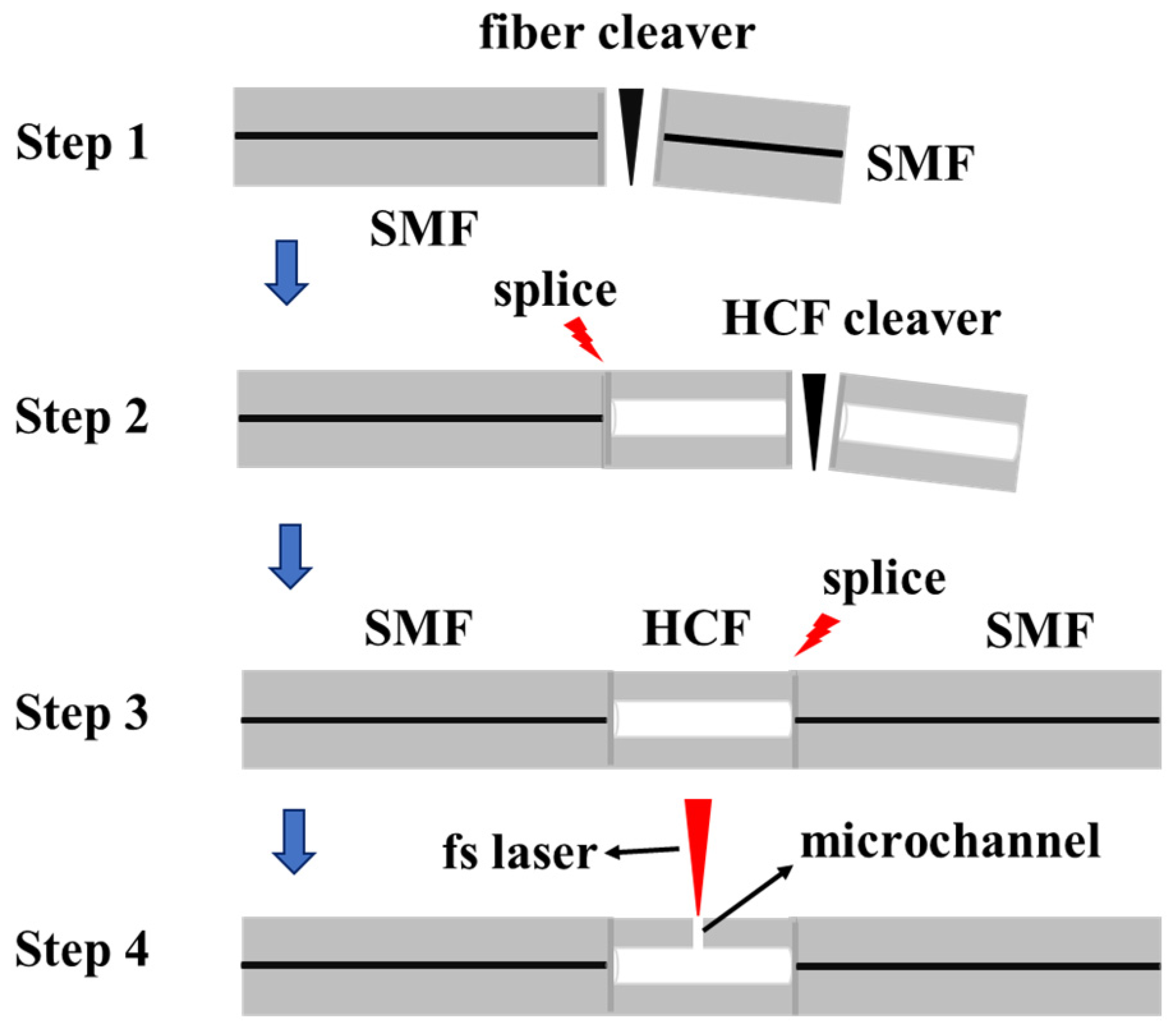


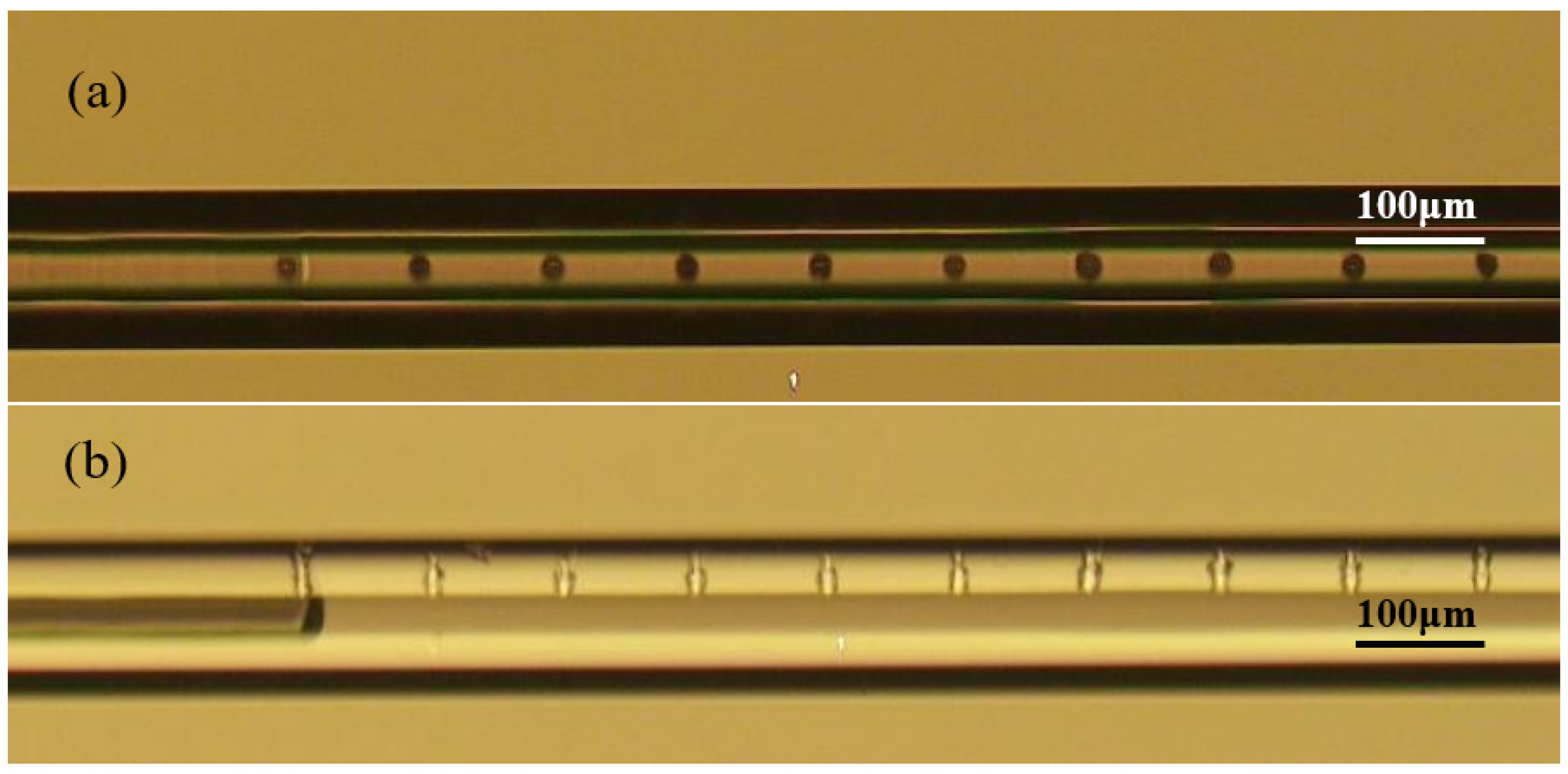
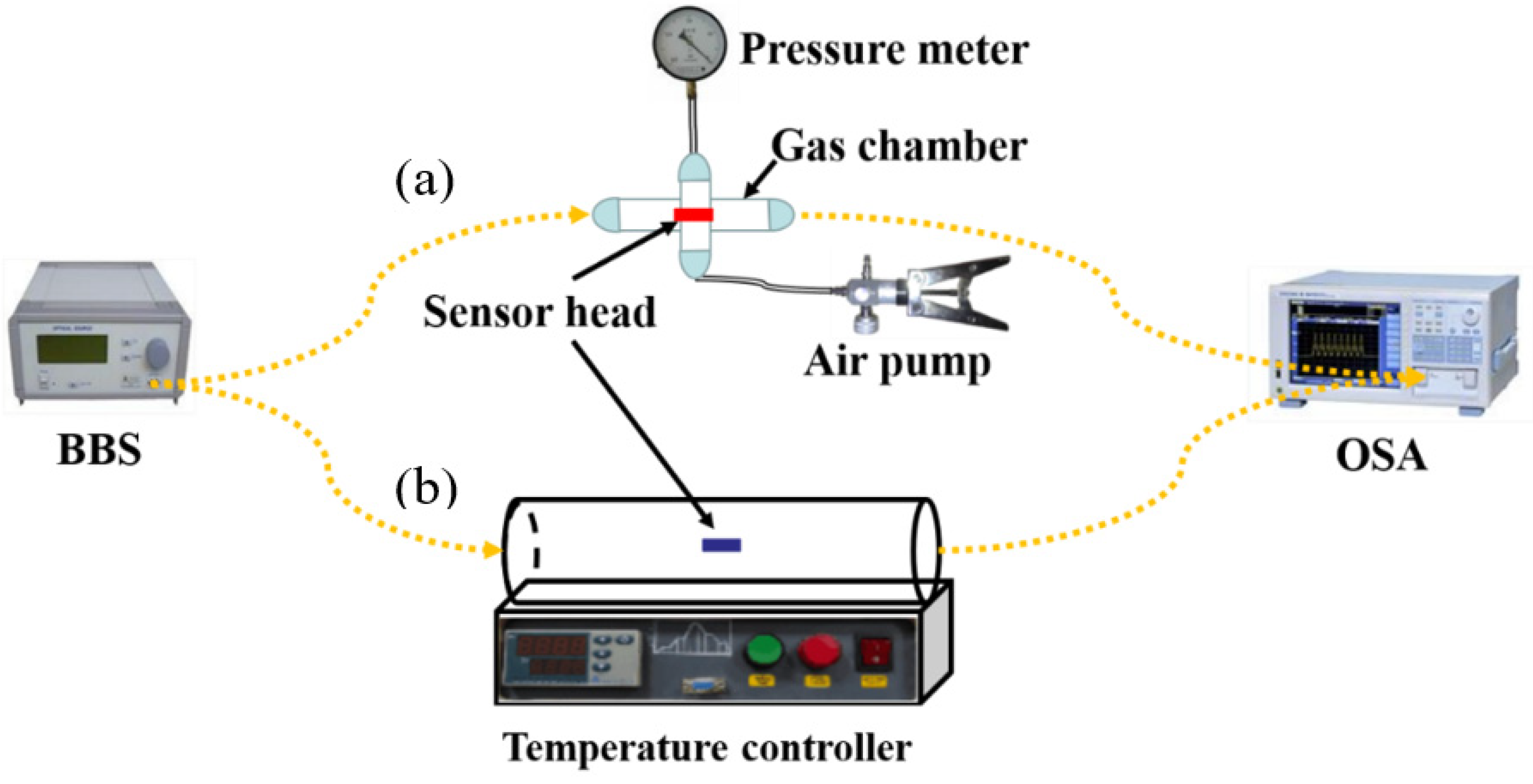
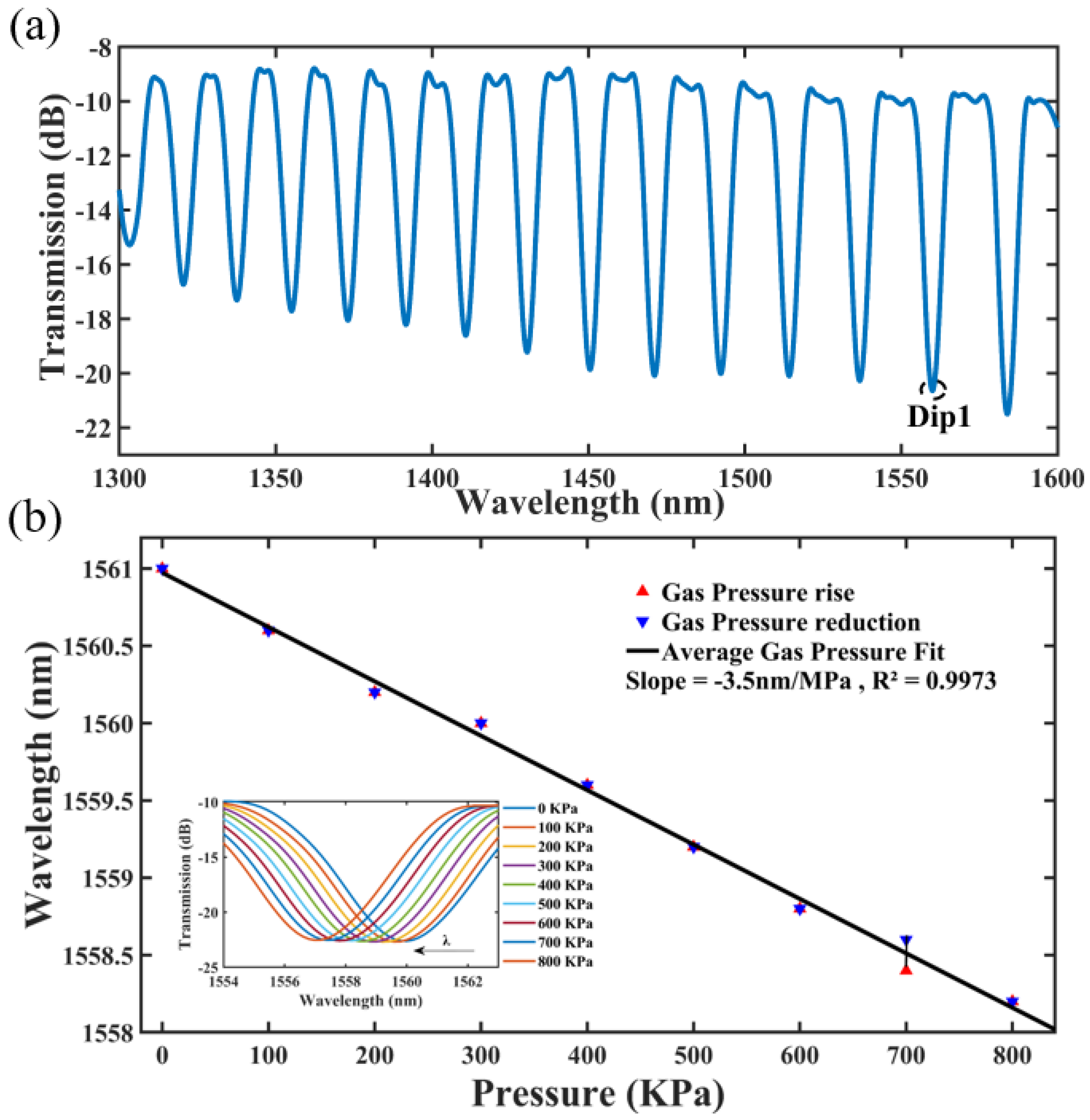

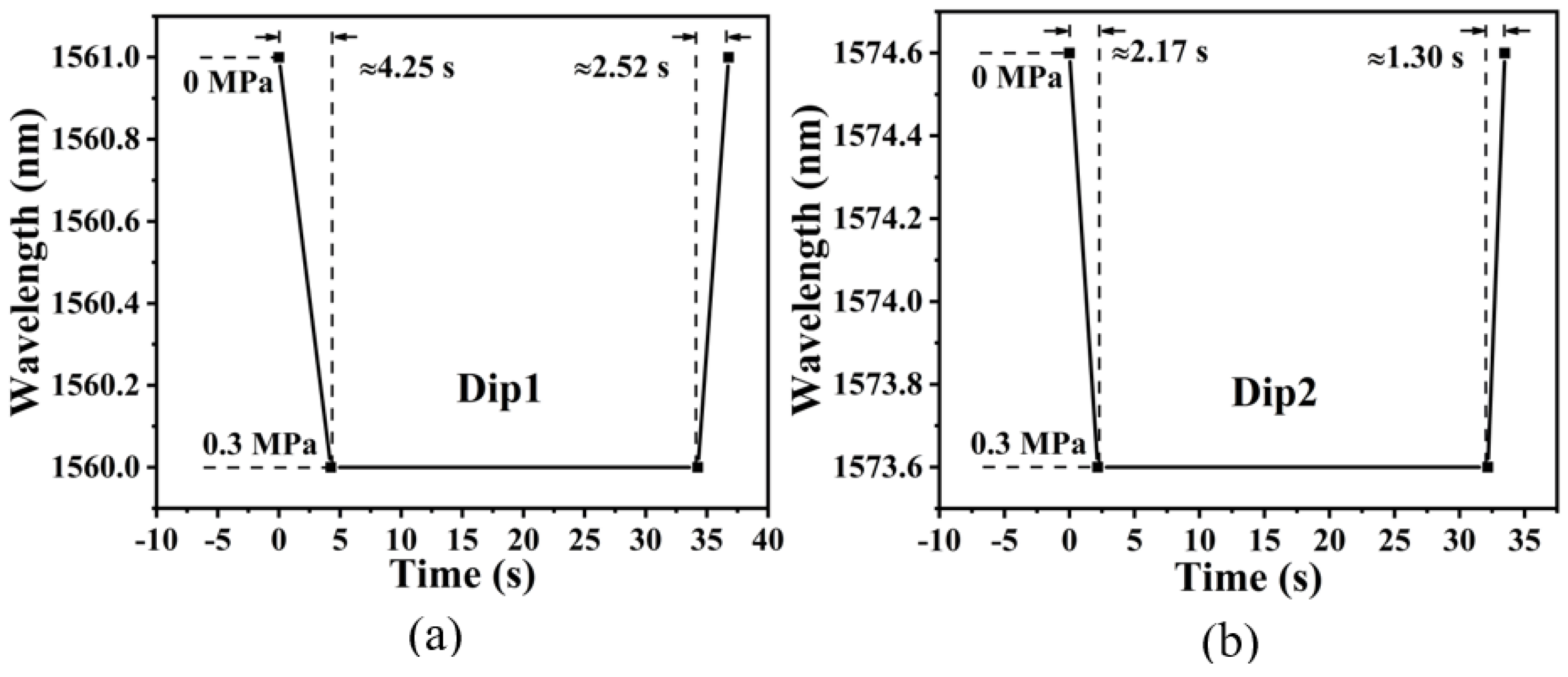
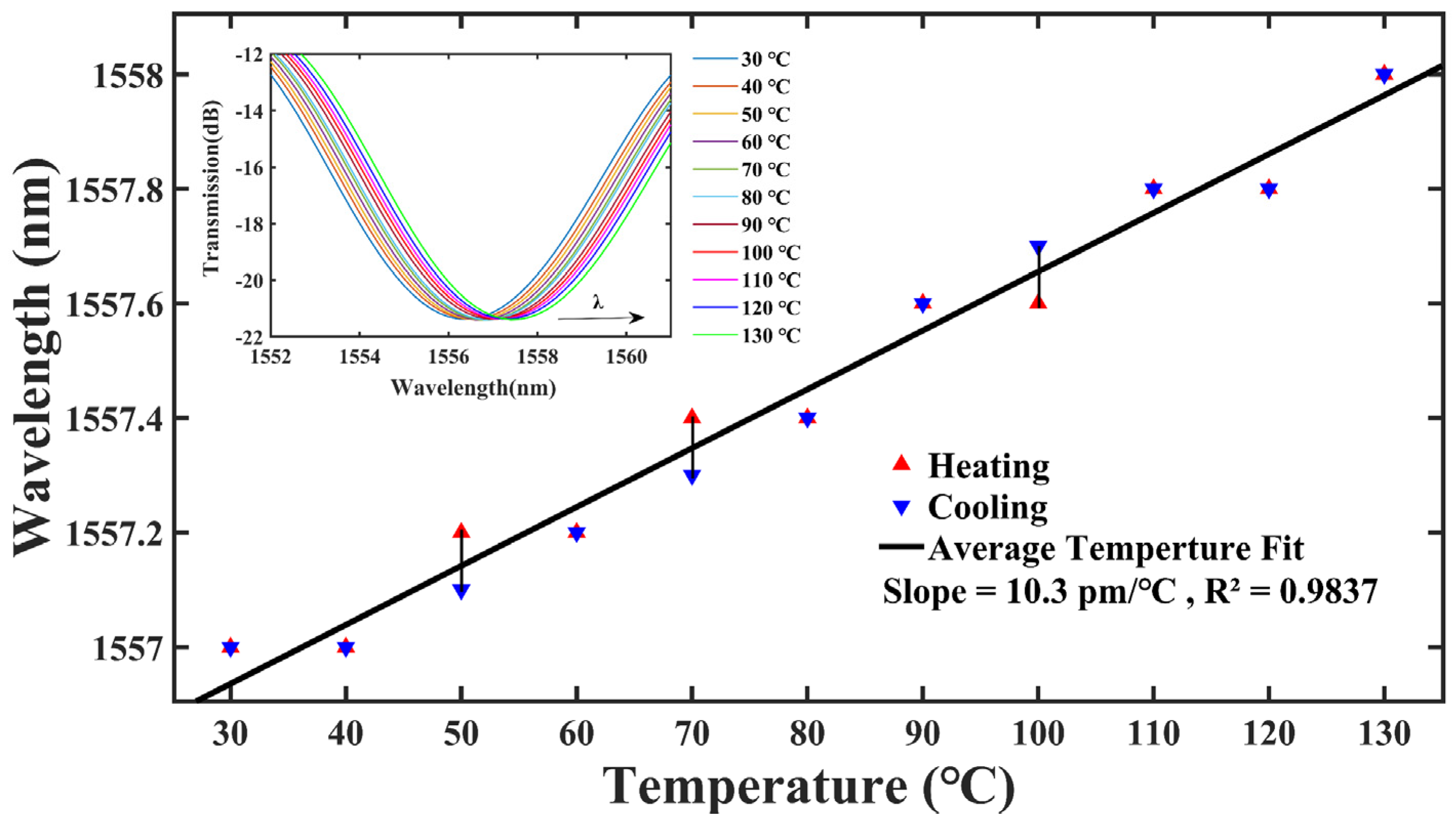
Disclaimer/Publisher’s Note: The statements, opinions and data contained in all publications are solely those of the individual author(s) and contributor(s) and not of MDPI and/or the editor(s). MDPI and/or the editor(s) disclaim responsibility for any injury to people or property resulting from any ideas, methods, instructions or products referred to in the content. |
© 2022 by the authors. Licensee MDPI, Basel, Switzerland. This article is an open access article distributed under the terms and conditions of the Creative Commons Attribution (CC BY) license (https://creativecommons.org/licenses/by/4.0/).
Share and Cite
Liu, C.; Tao, W.; Chen, C.; Liao, Y. Fabricating Air Pressure Sensors in Hollow-Core Fiber Using Femtosecond Laser Pulse. Micromachines 2023, 14, 101. https://doi.org/10.3390/mi14010101
Liu C, Tao W, Chen C, Liao Y. Fabricating Air Pressure Sensors in Hollow-Core Fiber Using Femtosecond Laser Pulse. Micromachines. 2023; 14(1):101. https://doi.org/10.3390/mi14010101
Chicago/Turabian StyleLiu, Changning, Wuqiang Tao, Cong Chen, and Yang Liao. 2023. "Fabricating Air Pressure Sensors in Hollow-Core Fiber Using Femtosecond Laser Pulse" Micromachines 14, no. 1: 101. https://doi.org/10.3390/mi14010101
APA StyleLiu, C., Tao, W., Chen, C., & Liao, Y. (2023). Fabricating Air Pressure Sensors in Hollow-Core Fiber Using Femtosecond Laser Pulse. Micromachines, 14(1), 101. https://doi.org/10.3390/mi14010101




